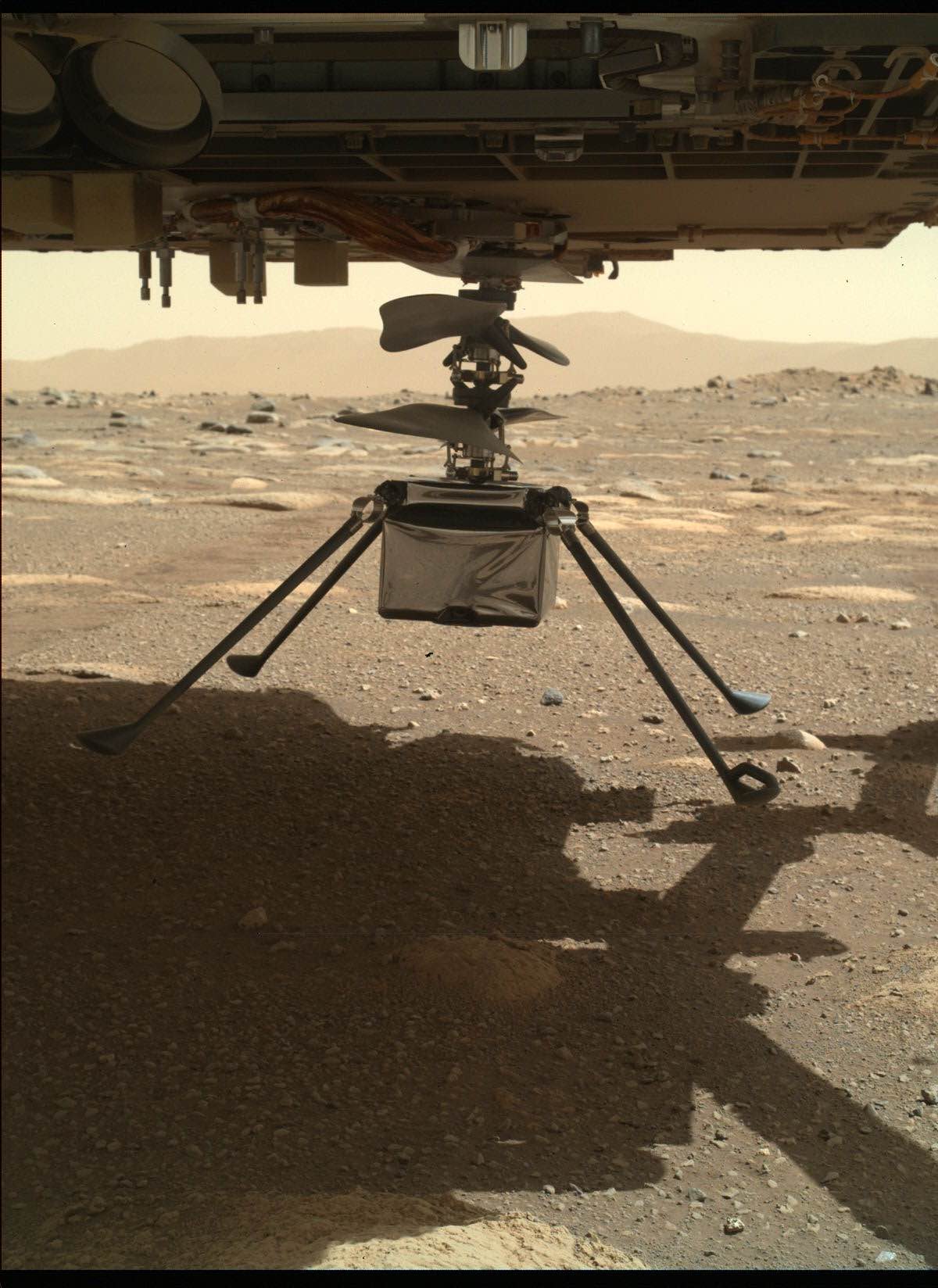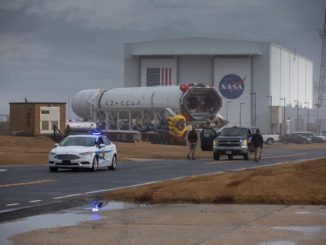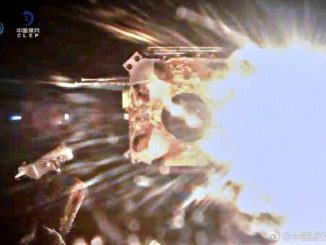EDITOR’S NOTE: Updated at 7:45 p.m. EDT (2345 GMT) with a fresh pictures of all four landing legs deployed.

NASA’s Ingenuity helicopter is being lowered from the belly of the Perseverance rover this week as ground teams run through a choreographed long-distance command sequence to safely release the $80 million rotorcraft onto the surface of Mars.
The slow, step-by-step deployment is projected to take around six days, assuming everything goes as planned. The first command uplinked from engineers at NASA’s Jet Propulsion Laboratory was to release a launch lock that kept the Ingenuity helicopter firmly attached to the belly of the Perseverance rover during the journey to Mars.
Images captured by a camera on the end of the rover’s 7-foot-long (2.1-meter) robotic arm showed the launch lock was released over the weekend.
Then a pyrotechnic device cut a cable to allow Ingenuity to begin rotating out of its horizontal position underneath the rover, and the helicopter extended two of its four landing legs. Pictures from the rover’s robotic arm camera Sunday showed the helicopter tilted at an angle below the craft’s belly, as expected.
An electric motor then fully rotated Ingenuity into a vertical orientation underneath the rover, a step confirmed in imagery downlinked from Mars on Monday. The helicopter’s body measures about 1.6 feet (0.5 meters) tall.
The deployment sequence continued Tuesday to extend the helicopter’s other two landing legs. At that point, the helicopter remained attached to the rover by a single bolt and a couple of tiny electrical connectors, according to NASA.
On the day before Perseverance releases the helicopter, the Ingenuity team at JPL will fully charge the rotorcraft’s six battery cells using electricity from the rover’s plutonium power source. Then the rover will sever its connection to the helicopter to drop about 5 inches (13 centimeters) down to the Martian surface.
If ground teams determine the deployment sequence is going well, the helicopter could be deposited on the Martian surface by the end of this week.
As soon as next week, the rotorcraft could make the first powered flight in the atmosphere of a planet beyond Earth. Future missions to other worlds could use aerial scouts to reach locations beyond the range of ground-based vehicles.
The six-wheeled Perseverance rover landed Feb. 18 in Jezero Crater, which scientists say contained a large lake of liquid water more than three billion years ago. Since the landing, Perseverance has activated its cameras and instruments and scouted a flat “airfield” for Ingenuity to take off and land on a series of test flights next month.
Earlier this month, the rover jettisoned the debris cover that shielded the 4-pound (1.8-kilogram) rotorcraft for landing.
Swing low, sweet helicopter…@NASAPersevere is slowly and carefully deploying the #MarsHelicopter, Ingenuity. The tech demo is currently unfolding from its stowed position and readying to safely touch down on the Martian surface. See upcoming milestones: https://t.co/TNCdXWcKWE pic.twitter.com/3AyaiHOH2k
— NASA JPL (@NASAJPL) March 30, 2021
Once Ingenuity is on the ground, the Perseverance begin driving away from the helicopter. Its destination will be an observation point at least 200 feet, or 60 meters, away from Ingenuity’s flight zone, which itself is about the length of a football field. The flight zone includes an airfield, a 33-by-33-foot (10-by-10-meter) area where the helicopter will take off and land.
The Ingenuity helicopter is a technology demonstration, and the autonomous test flights will come with risks. NASA wants to ensure the Perseverance rover is a safe distance away from the rotorcraft when it takes off.
There will be a bit of drama after the rover releases the solar-powered helicopter onto the surface.
Ingenuity’s batteries can power the helicopter and keep its internal electronics warm for about 25 hours before they need recharged. The rover will be shading Ingenuity’s solar panels after it releases the aircraft, so it will have to drive away within a day to allow sunlight to illuminate the helicopter, according to Farah Alibay, an engineer who oversees Perseverance’s integration with the Ingenuity helicopter.
“We will go through a number of days of commissioning, approximately a week, where we test out sensors, we test out solar mechanisms, we test the motors to make sure they spin right, and we will be very methodical and even driven as this engineering experiment unfolds,” said Bob Balaram, Ingenuity’s chief engineer at JPL, in a press briefing last week. “And then we will be at a point where we will undertake our first flight and then we will progressively undertake more aggressive flights once we understand and analyze all the behaviors on that first flight.”
Ingenuity’s counter-rotating rotors span about 4 feet tip-to-tip, and the blades will spin up to 2,537 rpm — more than 40 times per second — while the helicopter remains on the ground, a final test before engineers commit the aircraft to flight.
“Our current best estimate of when the (first) flight could happen is no earlier than about April 8, but things are fluid,” Balaram said last week. “We are very event and experiment driven, so that could be changed by a few days in either direction, but the best guess that we have right now is about April 8.”
Engineers plan up to five test flights, starting with an ascent to an altitude of about 10 feet (3 meters), where the craft will hover for about 30 seconds before making a turn and landing back where it took off. Further test flights will reach a maximum altitude of about 16 feet (5 meters), and introduce forward motion to carry the helicopter down the flight zone and back to its takeoff location.
NASA has set aside one month for the Ingenuity helicopter’s demonstration flights, with the clock starting when the rotorcraft is released onto the surface of Mars.
After the 31-day helicopter test campaign, the Perseverance rover will continue on its primary mission to identify, collect, and seal rock samples for return to Earth by a future mission.
The $2.7 billion Perseverance mission will search for signatures of past life on Mars, test an instrument designed to generate oxygen from carbon dioxide in the Martian atmosphere, and study the geology of the Jezero Crater landing site.
Scientists believe an ancient river flowed into the lake that once filled Jezero Crater. The dried-up river delta, located a little more than a mile from Perseverance’s current location, is the rover’s first major scientific target.
Email the author.
Follow Stephen Clark on Twitter: @StephenClark1.



